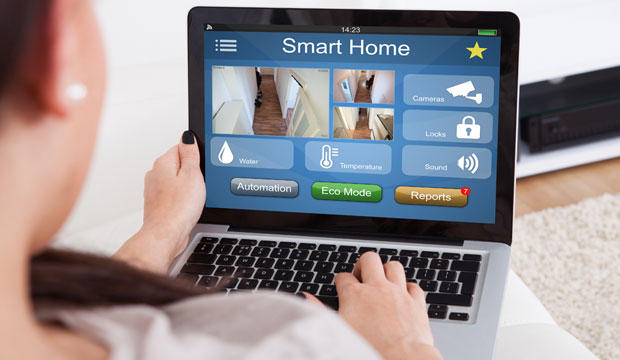Continued innovation and messaging are crucial for smart safety and security device manufacturers that want to capitalize on new opportunities in the emerging Internet of Things.
Early adopters of smart devices are often drawn to the innovative design and technological gadgetry. However, mass market adoption depends on clear and compelling value propositions that appeal to the masses when they seek a solution for a personal use case.
Connecting Outlier and Everyday Use Cases
Several challenges exist to meet those demands, and new use case options will impact the smart security and safety segment in 2017 and beyond. One key challenge for security and safety devices is to apply the value of the devices to specific, existing needs recognized by homeowners. For instance, what are the everyday challenges they can address, while also providing protection for the outlier possibilities of burglary or fire?
Video doorbells, for example, serve as entry-point security to ward off potential burglars, but they also identify when the kids come home or if a package has been delivered. Smart door locks not only protect against stolen or lost keys, but also provide remote access to guests and neighbors or automated lock/unlock functions based on owner proximity.
Motion sensors can be triggered in the rare occasion that an intruder threatens property, and they also can be embedded with sensors that help improve a home’s air quality every day.
What these examples suggest is that peace of mind is derived less from security-specific uses than from safety or welfare use cases that free owners from worry by keeping them informed about the status of their homes and loved ones. Value propositions for safety and security devices will be strengthened when consumers perceive everyday connections.
Personalized Use Cases and Segmentation
In addition to finding universal value propositions, the beauty of the smart home is that it can provide solutions to personal and unique use cases.
The multiplicity of use cases for smart home devices suggests companies must carefully mesh marketing messages to specific segments, such as young renters, families with young children, families with teens, aging adults and their caretakers, urban and suburban locations, and consumers undergoing life transitions (birth, marriage, divorce, death).
Also, the segmentation may not be so much demographic as it is a common concern shared by a group of consumers. Enabling device and system personalization is one way to address a variety of use cases. The more consumers can uniquely configure their security devices and services to fulfill their needs, the stronger the value proposition.
Expansion of Self-Installable Devices and New Monitoring Options
Also guiding the expansion of the safety and security device market is the emergence of smart devices that are easy to self-install, set up and self-monitor. This expansion goes beyond the professional monitoring segment, which has been relatively stable for years.
On average, 45-50 percent of smart safety and security devices are installed by the owner or a friend or family member; this varies slightly by device. The other half of the market still prefers professional installation.
Three options have emerged for self-installed devices and systems. Devices that are both self-installed and self-monitored provide alerts to multiple users, video confirmation of a security event in the case of networked cameras, and the ability to notify safety authorities directly from the app.
Self-installed security systems with professional or optional professional monitoring offer the consumer lower-cost systems without the burden of professional installation costs. The newest option is professional monitoring services for self-installed devices rather than just for whole systems, such as the ADT Canopy service.
Historically, there has been a tendency among consumers to perceive that a security system must be installed and monitored professionally to provide “real security.” Self-monitored systems are challenging this perception.
It remains to be seen whether they will simply reach new consumers with no interest in professional services, or erode the classic customer base for professional security services. Part of the value equation is whether the peace of mind from 24/7 professional monitoring is worth the average recurring monthly cost and accompanying contracts.
Some customers may also wonder whether public safety answering points (PSAP) that process 911 calls respond in the same way to citizen-reported alarms compared to those from professional central monitoring stations (CMS). The clearest answer by law enforcement seems to be that the calls will be treated the same if verification exists.
Consumers, however, cannot initiate a call for help if they don’t receive an alert in cases where they are otherwise occupied, their phone is unavailable, or their phone battery has run down. Some companies are looking for the device to send an alert to the first responders for urgent needs like fire and medical.
Some self-monitoring customers may become so familiar with the value propositions of security devices that a portion of customers migrate to professional services as cost becomes less of a factor and monitoring is perceived as providing a higher level of security. For this reason, major professional security companies have evolved to support self-installable devices.
Consumer Expectations on the Rise
In addition to self-installation convenience, consumers increasingly want simple, easy-to-use smart security devices and applications. Elevated product designs and clean user interfaces challenge traditional security system providers to improve their offerings’ appearance and ease of use.
While consumer understanding of device intelligence is nascent, some new connected devices, such as the Nest Cam, are raising the bar for the minimally acceptable product by integrating such cloud-supported capabilities as machine learning and security-oriented algorithms.
Strong Ecosystems Emerge
In addition to self-installable solutions, strong ecosystems organized around interoperability protocols, product developer platforms, professional services and big tech brands have emerged in the smart security marketplace.
Ecosystems are well established around brands like Z-Wave or ZigBee, but there is increasing interest in achieving interoperability at the application layer. The development of WiFi devices and combination Bluetooth low energy/IP-compatible devices creates new ecosystems that achieve automation through cloud-to-cloud communication by way of application program interfaces. This circumvents the need for a gateway hub.
Several interoperability initiatives are making strides in providing interoperability across a range of industry verticals. To that point, the partnership announced by ZigBee and Thread in early 2016 exemplifies the commitment to integrate a legacy radio frequency protocol with a newer IP protocol to reduce interoperability fragmentation. Still, the various protocol ecosystems are not expected to converge for several more years — if ever.
Ecosystems are also emerging around language processing. Apple HomeKit and Amazon Echo each have strong ecosystem plays around natural language processing and voice control through these proprietary devices.
Google has created an IoT operating system, Brillo, and a cross-platform communication protocol, Weave, to enable easy integration with the Android ecosystem. These various ecosystems define and differentiate the value of smart security devices for some consumers, though for others they are understood simply through the lens of “which device works with another.”
The strategic move of tech giants Amazon, Apple and Google into the smart home space promises an intense layer of competition already shared by hardware, security, broadband and utility companies. This fragmentation of ecosystems is likely to persist, and device makers will be challenged to bet on one ecosystem with a sizable shared audience, develop device models for various ecosystems, and embed multiple compatibilities within a single device.
An integral part of the product value for these devices is the user experience through apps and voice control. As consumers increasingly engage with connected home devices and services through apps via alternative devices — smartphones, tablets, computers, smart TVs, streaming media devices, connected cars, wearables and speakers — the user experience accompanying these apps becomes a vital extension of the security device’s or system’s value.
Home security and smart home platforms, as well as hero standalone devices, seek to differentiate themselves through a superior UX. The user’s interaction must be as frictionless as possible at all stages — from installation and setup to daily operation.
The introduction of voice control — with Amazon Echo and Alexa technology and the slower-to-market Apple HomeKit certified products — signals a new era in device interfaces. The ease of engaging with Alexa or Siri by calling their names and then issuing a command provides a natural, human-like interaction, one with which consumers are becoming increasingly familiar.
Many smart home device makers, without the capacity or interest in developing their own natural language processing interface, welcome Alexa integration. As of Q4 2015, almost 52 percent of iPhone owners had engaged with Siri and almost 32 percent of Android smartphone owners had used Google Now.
Alexa’s natural language processing technology already has been integrated with SmartThings, Vivint, Insteon, Wink, Philips Hue and Ecobee platforms, among others.
Growth in voice control usage may ultimately provide the frictionless interface needed to help drive mass adoption of smart home devices. A major beneficiary of that mass adoption would be the smart security market, with the increasing integration of smart home control with professional security services creating a climate for partnership development. Those partnerships will lead to more proprietary development, or acquisition by the major security players.







































A new type of "hybrid" innovations turn tablets into smart devices just by installing an app that can interact with other smart home devices and turn the tablet into an always-on smart device. As we see more cheaper tablets from known vendors like Amazon Fire, the barrier of entry for the average consumer is lowered. Since those tablets are actually a small computer the options are limitless. Check out WhizScreen as an example.